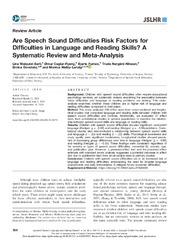| dc.contributor.author | Sørli, Line Walquist | |
| dc.contributor.author | Caglar-Ryeng, Ømur | |
| dc.contributor.author | Furnes, Bjarte Reidar | |
| dc.contributor.author | Nilssen, Trude Nergård | |
| dc.contributor.author | Donolato, Enrica | |
| dc.contributor.author | Melby-Lervåg, Monica | |
| dc.date.accessioned | 2025-01-09T13:02:17Z | |
| dc.date.available | 2025-01-09T13:02:17Z | |
| dc.date.issued | 2025-01-02 | |
| dc.description.abstract | Background: Children with speech sound difficulties often require educational psychology services, yet systematic reviews examining the association between these difficulties and language or reading problems are lacking. This meta-analysis examines whether these children are at higher risk of language and reading difficulties compared to their peers.<p>
<p>Method: The study analyzed 290 effect sizes from cross-sectional and longitudinal studies that compared language and reading skills between children with speech sound difficulties and controls. Additionally, we evaluated 37 effect sizes from correlational studies in general populations to examine the relationship between speech sound skills and language or reading skills.<p>
<p>Results: Children with speech sound difficulties showed significant concurrent language (Hedges' g = −0.60) and reading (Hedges' g = −0.58) problems. Correlational studies also demonstrated a relationship between speech sound skills and language (r = .23) and reading (r = .23) skills. Phonological awareness and study quality were significant moderators. Longitudinal studies showed persistent or increasing group differences over time in language (Hedges' g = −0.85) and reading (Hedges' g = −0.50). These findings were consistent regardless of the severity or types of speech sound difficulties, nonverbal IQ, country, age, and publication year. However, a precision-effect test and the precision-effect estimate with standard errors analysis suggested a potential decrease in effect size due to publication bias from small sample sizes in primary studies.<p>
<p>Conclusion: Children with speech sound difficulties are at an increased risk of language and reading difficulties, emphasizing the need for broader language assessments and early interventions to mitigate future academic difficulties. | en_US |
| dc.identifier.citation | Sørli, Caglar-Ryeng, Furnes, Nilssen, Donolato, Melby-Lervåg. Are Speech Sound Difficulties Risk Factors for Difficulties in Language and Reading Skills? A Systematic Review and Meta-Analysis. Journal of Speech, Language and Hearing Research. 2024 | en_US |
| dc.identifier.cristinID | FRIDAID 2329354 | |
| dc.identifier.doi | 10.1044/2024_JSLHR-24-00170 | |
| dc.identifier.issn | 1092-4388 | |
| dc.identifier.issn | 1558-9102 | |
| dc.identifier.uri | https://hdl.handle.net/10037/36143 | |
| dc.language.iso | eng | en_US |
| dc.publisher | American Speech-Language-Hearing Association (ASHA) | en_US |
| dc.relation.journal | Journal of Speech, Language and Hearing Research | |
| dc.rights.accessRights | openAccess | en_US |
| dc.rights.holder | Copyright 2024 The Author(s) | en_US |
| dc.rights.uri | https://creativecommons.org/licenses/by/4.0 | en_US |
| dc.rights | Attribution 4.0 International (CC BY 4.0) | en_US |
| dc.title | Are Speech Sound Difficulties Risk Factors for Difficulties in Language and Reading Skills? A Systematic Review and Meta-Analysis | en_US |
| dc.type.version | publishedVersion | en_US |
| dc.type | Journal article | en_US |
| dc.type | Tidsskriftartikkel | en_US |
| dc.type | Peer reviewed | en_US |


 English
English norsk
norsk
